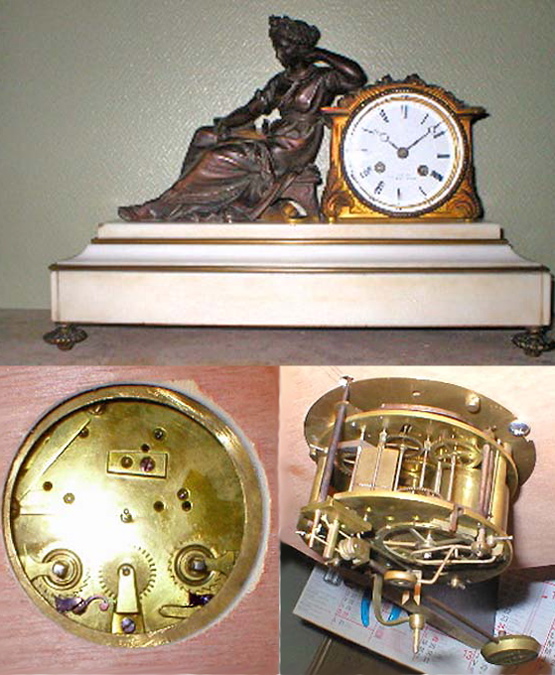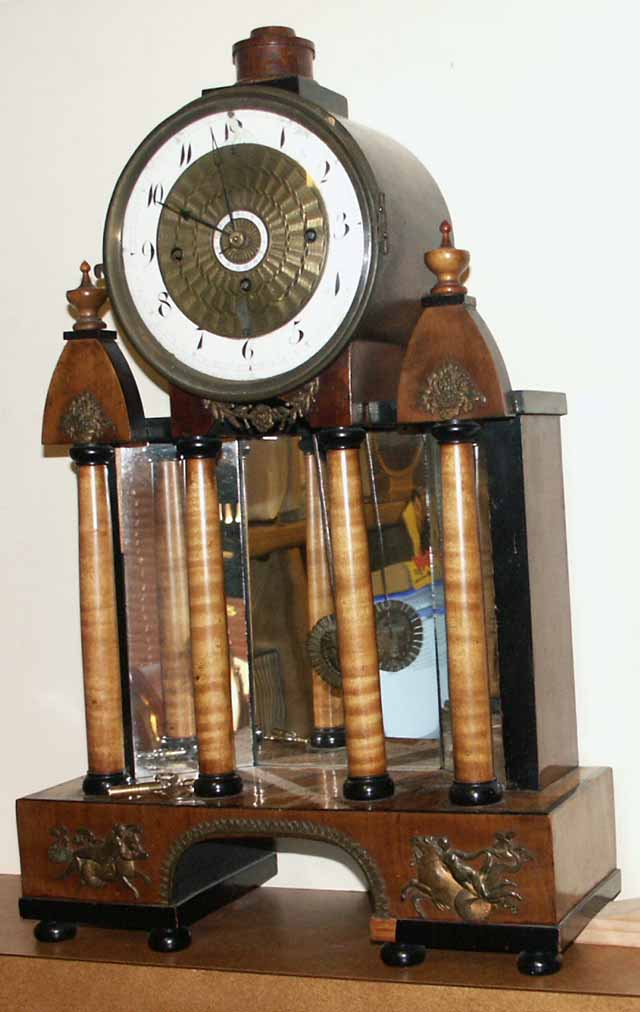
| WWT Shows | CLICK TO: Join and Support Internet Horology Club 185™ | IHC185™ Forums |

|
• Check Out Our... • • TWO Book Offer! • |
Welcome Aboard IHC185™  Internet Horology Club 185
Internet Horology Club 185  IHC185™ Discussion Site Main Page
IHC185™ Discussion Site Main Page  Technical, Shop Talk and Internet Links
Technical, Shop Talk and Internet Links  Clock Repair Questions and Answers
Clock Repair Questions and Answers  Silk Thread Pendulum Attachment
Silk Thread Pendulum Attachment
 Internet Horology Club 185
Internet Horology Club 185  IHC185™ Discussion Site Main Page
IHC185™ Discussion Site Main Page  Technical, Shop Talk and Internet Links
Technical, Shop Talk and Internet Links  Clock Repair Questions and Answers
Clock Repair Questions and Answers  Silk Thread Pendulum Attachment
Silk Thread Pendulum AttachmentGo  | New Topic  | Find-Or-Search  | Notify  | Tools  | Reply to Post  |  |
I am working getting a old French mantel clock working. The clock works seems free but I am stumped as to how to setup the pendulum. The clock was supposed to have a silk thread to suspend the pendulum in place of the metal spring. How long a thread loop? Is thread size important? Any help appreciated.. James | |||
|
Jim, The French silk string clocks I have worked on have had a hook on the top of the pendulum which attaches to a loop in the silk string. The movement crutch usually encircles the pendulum shaft. I think that silk was used because they did not have nylon, etc. I have used high quality, heavy thread for the suspension on these clocks. Something synthetic in the nature of heavy thread to very light string. I prefer synthetic string as organic materials are prone to be attacked by bugs, rot, and so on. The length will be determined by proper timekeeping. Start with a length you feel is reasonable and adjust from there. There is usually some mechanism to wind the suspension string, thereby making the pendulum shorter or longer. I have found these clocks won't keep time as well as a regulator because there are too many faults built into that suspension system. If that string coiling mechanism is missing, you are probably in trouble. I have found these clocks to be very touchy and somewhat of a problem to keep running. I have one that shows up every few months because the pin in the hand shaft works itself loose. When this happens the hands won't move because the pin tensions the hand "clutch." The hour hand also will slip on the tube and simply swing near the number six on the dial. The owner's grandson has been known to adjust the suspension to the point that the pendulum won't swing. The clock I have got to know so well is a Portico and very unique. It has a true blind man's strike as it sounds the quarters on one gong and repeats the hour count on another gong. If the clock were here, I could take a few pictures of it for you. I do not expect to see it for a few months as its last visit was recent. If you can, post a few pictures of the back of the movement and the pendulum. Maybe that will help us to see what is going on. Best Regards, Dick | ||||
|
Bonjour Dick, Thank you for your comments. I am working with a Japy Freries, 85 mm diameter movement. The chime drive has two pinions with missing teeth but I believe I will be able to cannibalize another movement for replacements. These movements are fairly common. I have been trying to get the time drive working before I pull it apart hoping to identify all the problems at once. I have the correct pendulum and identified the windup rod for the suspension thread. After some playing around I have the time train working with a piece of what looks like waxed thread. Good enough for now. I am interested in your experience with different thread materials. Any thoughts about a synthetic line like fishing leader? Touchy is right. I have the works mounted on a piece of plywood and found it is very sensitive to rotation. The pendulum must hang down at just the right angle or the works will stop before 30 seconds. I can imagine if you are not careful winding the springs you might rotate the clock too much and stop the pendulum. Regards, James | ||||
|
Howdy James, I think any synthetic string or thread is appropriate. My big concern would be with the gauge and flexibility. I think fishing line would work well, if it is the braided type. Having the clock "in beat" is probably a necessity. Likely the movement is worn, as well. Since this is not a common movement/clock in most of the world, I am sure the message board participants would enjoy seeing pictures of the clock and movement. Welcome to the message board. We all will be looking forward to hearing from you. Best regards, Dick | ||||
|
Hello All, My little French Black marble clock is very susceptable to stopping if slightly out of beat, However I have the fixing/holding strap screws snug but loose enough to allow movement to be slightly turned to enable me to check and corrct beat. I hold movement firmly when winding to prevent rotation by accident. It has a conventional French suspension spring not Silk as the clock in question. Regards ,Ged.  | ||||
|
Bonsoir Dick, Thanks again for the helpful comments. I am trying to attach some pictures to this message which will show the pendulum system. The clock has been running since this conversation started so I think the time works are all intact. That was my main concern before disassembly to replace some of the chime train. I was able to find a complete movement on EBAY and I’ll receive it in a few days. As the pictures show the clock house and statue are very tarnished. I now have all the pieces apart. The statue is in five parts, all separate castings. Quite interesting how these things are made. The statue and house are also very dirty from probably smoke since these clocks were often set on fireplace mantels. Since they are not easy to move to adjust the pendulum length the string suspension allowed an easy adjustment from the front of the clock. My clock has four screw adjustable feet so leveling should be straightforward. I don’t see any adjustment on Ged’s clock. A very pretty example of French marble cased mantle clocks. Regards, james  | ||||
|
James, You were very fortunate to find a parts movement on Ebay, or anywhere for that matter. I looked a little further into my archives and found a picture of the silk suspension clock that comes to visit me. It follows. The dial is porcelain on the outside and has a brass center disc. Behind the pillars are mirrors, which have caused some reflection in the photo. The clock used to have a rather sharp finial at the top. The clock owner lost it in transporting the clock to my shop one time. Overall dimensions on the clock are about 17 inches tall by 10 inches wide. (approximately 40cm X 25 cm)  | ||||
|
| Administrative Assistant |
Jim sent along his pictures, we merged the three and placed them in his previous post. Take another look at Jim's January 28th post. Great topic guys! | |||
|
Greetings Dick and others, My thanks to Dr. Irvine and I would guess others for helping me post some pictures with this thread. Dick your STS clock is truly impressive. At almost a foot and one half tall it would take over my fireplace. I would give the dimensions of mine but it is all in pieces so that will have to be part of the “after” story. As near as I can tell these STS movements were disappearing from production by the middle of the nineteenth century. The French lump a lot of that style period under the label Napoleon III since he was the head of government during that time. I would like to have a more precise date for STS clocks. As to EBAY there are many interesting clocks listed here in France. You can search from the US site or try eBay.fr, it is in French of course but the layout is the same. Try a search with “pendule” or “pendule de paris”. If anyone is confused e-mail me and I will try to help. Regards, James | ||||
|
| Powered by Social Strata |
| Your request is being processed... |
|
©2002-2025 Internet Horology Club 185™ - Lindell V. Riddle President - All Rights Reserved Worldwide

